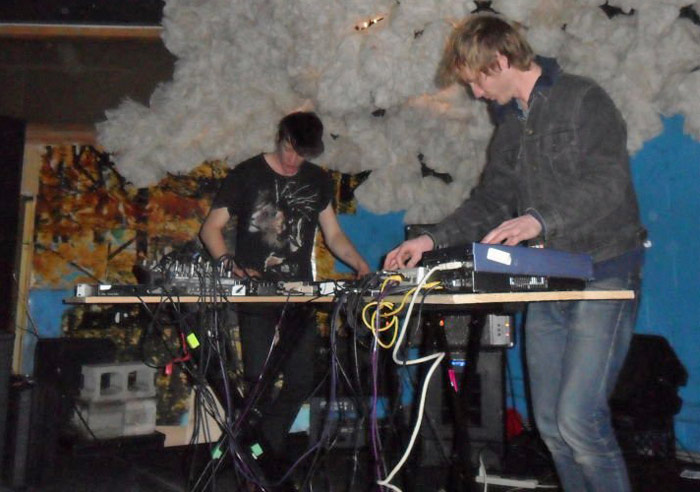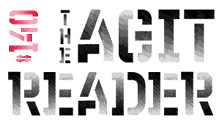
Wexner Center, Columbus, March 24
by Jennifer Farmer
Southern California is known for a brand of hazy, harmonic pop music, largely attributed to the Beach Boys, which came to fruition in the early 1960s. Languid imagery of infinite daylight creeps to mind, but association is different for everyone. The California sound does always goes hand-in-hand with a certain degree of nostalgia—even when those playing it (and listening to it) weren’t even in their parents’ 10-year-plan in the ’60s.
The aforementioned can be written about many such bands active in that California dream-pop revival of sorts (Beach House, Best Coast, etc.), as well as Papercuts, who made a stop by the Wexner Center to unleash a bit of sunbelt warmth on an unseasonably cold Midwest night.
Papercuts are the brainchild of soft-spoken Jason Robert Quever. Though he plays the role of the quintessential frontman, handling guitar and a majority of the vocal duties, he has ample help from a talented group of flannel-clad guys. Most notable among these is Graham Hill, one of the band’s few constant contributors, whose punchy drums accomplish the daunting task of breaking through the haze and echo without sounding overbearing.
Even with minor technical difficulties at the start, the entire set came up an Andy Rooney monologue short of an episode of 60 Minutes. Quever and company blazed through an affecting rendition of “Future Primitive,” at which point the sparse and largely sleepy audience noticeably perked up. Among these dream-pop fans, it was difficult to separate genuine excitement from the urgent need to employ an ever-so-slight toe-tap, since genuine affection for a band would never be betrayed among the modish few. This routine between the crowd and the band—a continuous barrage of songs, mellow, but devoid of energy save for the aural vibrations emanating from the speakers—continued for the remainder of the show.
While stage presence does not a musician make, it certainly helps a band connect with their audience. It’s a bit unnerving when a band’s stage banter (or lack thereof) actually evokes a palpable awkwardness. That being said, when the band did take the time to address the audience, Quever, who served as the mouthpiece, was heartwarmingly sincere, appreciative and genuinely stunned at the pleasant reception. Smiles and knowing glances were coyly exchanged when the band dove headfirst into the effective one-two punch for the close: the sweet single “Do What You Will” followed by perky gem, “Do You Really Wanna Know.”
The high point of the night, however, was the encore (or obligatory break where people clap politely and pretend to be fooled). In his most evocative dialogue yet, Quever declared, “We’re going to do something we don’t normally do for you guys.” Whether the Wexner Center was really privy to a one-off treat remains to be seen, but what followed was an acoustic rendition of “Judy,” showcasing the awe-inspiring vocal harmonies and moving lyrics that oft remain hidden behind the electric dream-pop haze.
I couldn’t be sure whether the near-hour spent bobbing and waving, head awash in a cloud of languorous pop was actually a dream, but leave it to the harsh Ohio winter-spring to snap me back to reality. Still, the faux California dreamin’ the Papercuts had me in could’ve lasted much longer.

GlassLands, Brooklyn, March 26
by Josie Rubio
Since the departure of bassist Jacob Long, remaining Mi Ami members Daniel Martin-McCormick and Damon Palermo have taken the band’s feverish post-punk sound into an electronic direction. Yet the frenetic urgency remains on the duo’s latest EP, Dolphins, thanks in part to Martin-McCormick’s distinctive near-falsetto that infuses the tracks with unrelenting energy. The new sound has layered soundscapes, only this time created with electronics in lieu of guitars and mixed with pulsing dance rhythms for something like a re-imagined, electroclash, if the emphasis was on the clash.
I was interested to see how this would translate to their live show at GlassLands, as I braved the blustery March winds on Williamsburg’s waterfront. Though I’d never seen their previous incarnation perform, two guys behind keyboards is a difficult dynamic live by any measure. Opener Laurel Halo set a promising stage with her mesmerizing blend of soaring, atmospheric sounds and skeleton-shaking, thumping beats. Halo singlehandedly conjured powerful and sophisticated dance melodies.
Mi Ami took the stage shortly afterwards and launched into a false start of “Hard Up,” the first track on Dolphins. While Palermo corrected the problem, Martin-McCormick joked about breaking the fourth wall and an audience member inexplicably said something about “animal t-shirts.” But once the band launched into the track, it didn’t disappoint, as Martin-McCormick sang and screeched with near-maniacal fervor. I had wondered why he kept stretching his arms before the band started, but now the method made sense to his onstage madness, as he contorted and danced like a marionette controlled by an erratic puppeteer with a twitch.
The vocalist’s stage presence was in sharp contrast to his engagement with the audience, as he thanked the people in the front row who were dancing and “losing their minds” and in the gallery’s lofted space, adding they were “close enough, I’ve been there.” One particular front row dancer almost seemed to become part of the show, and I came to think of him as the Man Who Danced with Reckless Abandon. It takes a lot of courage and coordination to dance with such conviction, and since I lack both, I left the dancing to him and the front-row crowd. Before performing Dolphins’ title track, Martin-McCormick said it was a song that’s about “everything that’s going on in the world.” (I had initially suspected that the song had been named to further confuse Google searches to lead to results for the Miami Dolphins, which does, I suppose, qualify as something going on in the world.) To the haunting repetition of “they wash ashore three by three” and moody, off-kilter keyboards and pounding rhythm, much of the crowd danced in the gallery, which currently has a “Futuristic Forest” theme, according to the space’s website. A stuffed bear head—not as in taxidermy, but the mounted head of a teddy bear—kept its button-eyed gaze over the venue. The stage light installation, resembling a cloud of rose blooms, provided a nice backdrop for the performance, and the oft-changing space was the perfect setting to see the ever-evolving Mi Ami.
Edwyn Collins Live Review
Lemmy: 49% Motherf**ker, 51% Son of a Bitch
Paul Collins Beat Live Review
The Church Live Review
Tusk 33⅓
The Dismemberment Plan Live Review
Complaints Choir
Gruff Rhys Live Review
Todd P Goes to Austin
Guided By Voices Live Review
Hüsker Dü: The Story of the Noise-Pop Pioneers Who Launched Modern Rock
Bob Marley and the Golden Age of Reggae 1975-1976
A Dead Boy's Tale from the Front Lines of Punk Rock
Roky Erickson Live Review
